Posted by Elena del Valle on May 31, 2012
Location: Boston, Mass
Organization Description
Third Sector New England provides management and leadership resources to help nonprofits support strong, healthy communities. With a staff of nonprofit professionals, TSNE is an effective fiscal sponsor, convener, consultant and grant maker, offering a unique blend of capacity-building programs and services. Our work also complements that of the funding community and other capacity builders.
Click to read the entire Third Sector New England Communications Manager
Posted by Elena del Valle on May 30, 2012
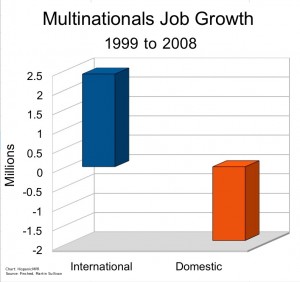
Multinationals Job Domestic and International Growth 1999-2008 – click to enlarge
It used to be that the pace of innovation kept employment numbers strong in the United States. As some jobs became obsolete and migrated overseas workplace evolution and new technologies resulted in the creation of new jobs that outpaced the losses. Over time, as innovation slowed, more jobs migrated out of the country than were created and access to cheap international human resources and continuous corporate desires for profit continue to fuel the trend with few or no tax consequences to stem the job losses.
In 2007 multinational companies employed 19 percent of the private sector workforce, earned 25 percent of private sector profits and paid 25 percent of private sector wages. For all their impressive presence and efficiency these companies were not noteworthy on the job creation side, according to a 2010 McKinsey Global Institute report cited in Pinched.
In the last 20 years, multinationals have been responsible for 41 percent of labor productivity in the United States corresponding to only 11 percent growth of employment in the private sector. The production cycle many relied on meant initial production in wealthy nations with abundant innovation that eventually moved to countries with lower labor costs. In the United States, hardware manufacturing and data processing jobs shrunk when both were expected to grow.
At the same time, and especially during the Great Recession, companies pushed for greater efficiency, driving staff to work longer hours and accomplish more with less. Some developed new processes and methodologies and others accomplished their efficiency goals by squeezing more hours and labor out of employees who feared for their jobs and way of life in a declining economy. These strategies have led to greater stock value for publicly traded companies and higher profitability for many companies overall at the expense of jobs lost that will likely never be recovered. Fewer jobs lead to a slower economy with consumers holding back and focusing on savings. This is especially true when prospective employees are trapped where they are living due to the lingering housing bubble.
An example of the trend is that between 1999 and 2008 multinationals in the United States cut back domestic employment by 1.9 million while boosting foreign employment by 2.4 million, according to economist Martin Sullivan (see Pinched and U.S. Multinationals Moving Jobs to Low-Tax, Low-Wage Countries at Tax.com). At the same time, the figures that reflect a domestic decrease in jobs do not appear to include loss of revenue domestically for individuals who suffered salary and benefits cuts by their multinational employers.
Posted by Elena del Valle on May 25, 2012
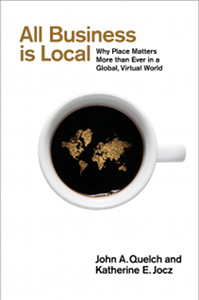
All Business Is Local book cover
Photos: Portfolio/Penguin, John Quelch and Katherine Jocz
I first heard about a chain of healthy fast food restaurants through a colleague across the country. Because of her high endorsement I tried the one nearest to me and liked it. Over time the food and service declined noticeably. I, and many others who used to stand in line there, stopped going. It doesn’t matter how popular the chain remains at the national level I no longer patronize it because the local restaurant is not to my liking. This might be what experts refer to when they say location matters.
Businesses, regardless of their size, must be local and global in order to thrive, according to John Quelch, dean, China Europe International Business School (CEIBS), and Katherine Jocz, a marketing consultant. In their book, All Business Is Local: Why Place Matters More Than Ever in a Global, Virtual World (Portfolio/Penguin Group USA, $25.95), published this year, John Quelch and Jocz explain their reasoning.
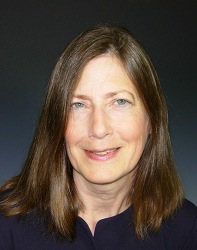
Katherine Jocz, coauthor, All Business Is Local
Too often companies focus on a global market and neglect local aspects, they say. The authors believe people shop at the stores that make sense to them regardless of the global efforts or reputation of the company that owns them or the brand. Location matters now more than ever, according to them. Place, they say in the Introduction, is “one of the most reliable bases for targeting and positioning decisions.” They stress that the more connected we become worldwide the more we will want to focus on local rather than global.
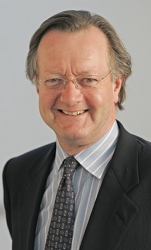
John Quelch, coauthor, All Business Is Local
Global brands like Real Madrid, Starbucks and McDonald’s are often local favorites because of their ties to the communities where they are located; adapting selections and menus to local tastes, buying locally, and employing locally are some of the strategies successful companies rely on, the authors say in the book.
The 248-page book is divided into one Introduction and five chapters: Managing Psychological Place, Managing Physical Place, Managing Virtual Place, Marketing Geographic Place, and Marketing Locally and Globally. Quelch was formerly associate dean of the Harvard Business School and dean of the London Business School. Jocz was formerly a research associate of the Harvard Business School and a director of networks and relationships at Marketspace.
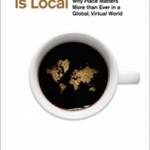
Click to buy All Business Is Local
Comments:
Filed Under: Books
Posted by Elena del Valle on May 23, 2012
Would You Trust a Machine With Your Brand’s Reputation? Technology is Great, but Successful Cross-Cultural Communication Requires a Human Touch
By George Rimalower
President of ISI Translation Services
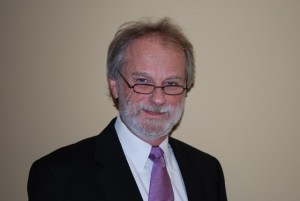
George Rimalower, president, ISI Translation Services
Photo: ISI Translation Services
Earlier this year the Malaysian Defense Ministry was mocked worldwide when its English translation errors went viral via social media.
Its staff dress code, published online, warned against “clothes that poke eye.” The history section of the ministry’s website explained: “After the withdrawal of British army, the Malaysian Government take drastic measures to increase the level of any national security threat.”
Anyone who’s had a cross-cultural experience of any kind has likely had at least one moment of absurd misunderstanding. In a personal situation it can be funny. In a business setting, it can be damaging.
Click to read the entire article Why not to trust a machine with the reputation of your brand
Posted by Elena del Valle on May 22, 2012
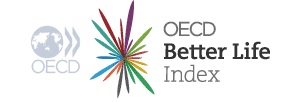
Graphic: Organization for Economic Co-operation and Development (OECD)
As we struggle in our day to day lives few of us stop to ponder the big picture. Are we happy? What does it take to have a good life? Is it education, money, a good balance of work and life, safety? Policy makers ask additional questions such as, do men and women want the same things when it comes to living well? Do people in different countries, even neighboring countries, share views about the common elements that lead to a high quality of life?
In 2004, the Organization for Economic Co-operation and Development (OECD) began to explore meaningful ways to establish quality of life. For the past two years the OECD has been looking a quality of life issues beyond just economics and gross domestic product (GDP) with the mission to “develop better indicators for better policies for better lives.”
Last year, for the first time, it released the results of its Better Life Index (BLI) in which researchers examined 11 indicators among 34 members of the organization including the United States and: Australia, Austria, Belgium, Canada, Chile, Czech Republic, Denmark, Estonia, Finland, France, Germany, Greece, Hungary, Iceland, Ireland, Israel, Italy, Japan, Korea, Luxembourg, Mexico, Netherlands, New Zealand, Norway, Poland, Portugal, Slovak Republic, Slovenia, Spain, Sweden, Switzerland, Turkey and United Kingdom.
To date one million visitors from 184 countries have visited the website to find out about the quality of life in the nations profiled. OECD staff looked at and shared their main findings about 11 Better Life Index dimensions: housing, income, jobs, community, education, environment, civic engagement, health, life satisfaction, safety, and work-life balance in 34 countries with the goals of developing good policies, allowing people to compare results, empower the public and make the information accessible. Those curious to know how their country compares with others among the 34 nations can see the latest results which become available today at http://oecdbetterlifeindex.org/
The top three drivers of well being were education health and life satisfaction and, according to their findings, there were only minor goal differences by gender. Across the board men work more and earn more. At the same time, women live longer, study more, are more social and in some countries are happier.
This year, Denmark had the highest life satisfaction and the highest work life balance, Switzerland was the country with the best health results, Finland showed the highest results in education, and Japan the highest results in security. The United States had the best ranking for income and housing.
Last year, 173,862 people visited the site from the United States; the cities with the highest participation were in descending order, New York, Washington, Chicago, San Francisco, Seattle, Los Angeles, Houston, Portland, Austin, and Boston.
The data used for the report came from the OECD or National Accounts, United Nations, and national statistics offices. Some were sourced from the Gallup World Poll, a division of the Gallup Organization that conducts public opinion polls in 140 countries around the world.
The mission of the Organisation for Economic Co-operation and Development (OECD) is to promote policies that will improve the economic and social well-being of people around the world.
Posted by Elena del Valle on May 18, 2012
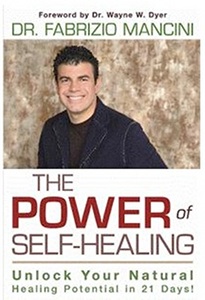
The Power of Self-Healing book cover
Photo: Teszler PR
Half of ill people if left alone will heal on their own. So believes a chiropractic and book author on the topic. Because traditional western medicine has focused on external healing most people are unaware of the power of their own bodies, he says.
Fabrizio Mancini, president, Parker College of Chiropractic, is convinced from personal experience and experience with patients that the human body has a built-in capacity to heal itself and that improving the body’s ability to heal can be controlled by each individual.
In The Power of Self-healing: Unlock Your Natural Healing Potential in 21 Days (Hay House, $24.95), published in 2012, the bi-lingual speaker explains his health theories and outlines his ideas on how readers can tap into their body’s own healing powers through: simple substitutions of daily diet-foods that he believes can contribute to a body’s ability to self-heal, the latest supplements he thinks can strengthen the body’s self-healing capacities, new insights into how physical activity floods the body with natural healing substances, the latest non-drug, non-invasive technologies he thinks can contribute to health, the power of the mind and spirit to heal the body, self healing case studies and his suggestions for a 21-day self-healing program.
The 280-page hardcover book is divided into four main parts Physical Self-Healing, Emotional Self-Healing, Spiritual Self-Healing and 21 Days to Self-Healing and 14 chapters. At the beginning of the book, Mancini, an immigrant from Colombia, shares a little about his arrival in the United States and why he decided on his path as a chiropractic and educator in life. In his opinion there is a basic difference between healing and curing; and there are three types of healing: physical, emotional and spiritual.
Exercise and diet can be good first steps toward self healing, according to the Texas resident. He dedicated the first chapter of the book to foods and the second chapter to things that he considered to have a detrimental effect or Anti-Healers. He discusses nutritional supplements, exercise and other forms of healing in the following chapters. Next he discusses the power of thoughts, emotions and in self-healing. He then addresses the role of creativity, forgiveness, gratitude, love including the importance of hugs and spirituality. The book ends with his recommendations for a 21-day healing program that includes a menu, supplements, exercise and a positive suggestion for each day.
A graduate of Parker College himself he is the co-author of Chicken Soup for the Chiropractic Soul and The Well Adjusted Soul; and author of Four Steps for Living a Fabulous Life.

Click to buy The Power of Self-Healing
Comments:
Filed Under: Books
Posted by Elena del Valle on May 16, 2012

Ron Bacardi de Maestros de Ron, Vintage, MMXII – click to enlarge
Video, photos: Bacardi
Earlier this year Bacardi, the international rum making giant, celebrated 150 years of operations with displays, parties, and a family reunion. Although the top selling Bacardi product in the United States is Grey Goose to mark the occasion the company announced Ron Bacardi de Maestros de Ron, Vintage, MMXII, a limited edition Bacardi blend the combined effort of eight Bacardi family members and former rum masters (maestros de ron). Scroll to watch video about Ron Bacardi de Maestros de Ron, Vintage, MMXII.
A “blend of the finest rums laid to rest in oak barrels over the last 20 years and finished in 60-year-old Cognac barrels,” the liquid, bottled in a hand-blown crystal decanter made in Mexico then housed in a leather case, retails for $2,000. At its release only 400 decanters were available for purchase at some airports and premium retail shops.
“We had the privilege of working with some incredible stocks of aged rum. We were looking for woody notes and fruity notes. We were looking for the balance and equilibrium that makes a great rum. The depth of flavor and character that this rum has is incredibly unique,” said Guillermo Garcia Lay, Bacardi Family master blender.
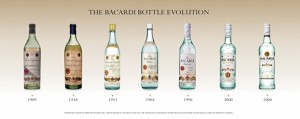
Bacardi bottles evolution – click to enlarge

Bacardi Bat evolution – click to enlarge
“I had an idea of what this rum should be and so did the other master blenders, so we tried to come up with one single Bacardi rum that would be good for all of us. And I think that if it is good for us, I think it will be good for everybody,” said Emilio Bacardí Bravo, Bacardi Family master blender.
The MMXII Vintage is described as “a highly aromatic, full-bodied and generous rum with a mellow flavor.” It is said to have an expansive nose with tropical fruits and sweet floral aromas, balanced with soft vanilla and a smooth oak character and enriched with notes of sweet Caribbean honey and fragrant fruits leading to a “long, pleasing finish with a smooth background of oak.”
The hand-blown crystal decanter was designed to represent El Coco, the coconut palm planted at the entrance of the first company distillery in Santiago de Cuba by the founder’s son 150 years ago. Etched onto the crystal decanter, next to the hand-pressed red crystal bat image, are the coordinates of 20 01 48.69N 075 49 56.86W that mark the birth place of the company rum in Santiago de Cuba. The decanter also features a map of the Caribbean pointing to the original distillery.
Founded on February 4, 1862, and family-owned for the past seven generations, Bacardi employs nearly 6,000 people, manufactures its brands at 27 facilities in 16 markets on four continents, and sells in more than 150 countries.
Posted by Elena del Valle on May 14, 2012

Nellie Gonzalez, host, Inside Mi Casa
Photos: Mi Casa Broadcasting
In January 2010, Talk Media Group, LTD., owned by Johnathan Gwyn and a private partner, established Mi Casa Broadcasting in Austin, Texas. Network executives hope it will have broad national appeal to English speaking and bilingual Latinos and be “the next ‘BET’ for Latinos.”
“Mi Casa Broadcasting is on mission to become one of the world’s preeminent media companies focusing on the new Latino American niche through cable strategic development including video-on-demand, pay-per-view, IPTV, and Wireless distribution and oversees the cable distribution,” said Gwyn, chief executive officer, Mi Casa Broadcasting, by email when asked about the company. “We want to provide advertisers a large Latino audience through properties we currently own like Dia Delivery, Latina Spice, and Please Estop It!”
Mi Casa Broadcasting, available on KTBU affiliate 55.4 in Southeast Texas, can be seen in 22 counties in the Greater Houston Area. The network also has a website, micasabroadcasting.com, where some of the programs are available for viewing.
Sixty percent of the network’s content is produced in house and 40 percent is licensed. The network staff produce eight programs per week and is working on a new program. The Mi Casa Broadcasting target audience is second generation English dominant Hispanic Americans aged 18 to 39 which network executives believe have “the biggest buying power of America.”

Johnathan Gwyn, CEO, Mi Casa Broadcasting
“We cater to your grandma who wants to speak English too,” said Gwyn. “We utilize strong social media and interactive media with our ability to send text messaging live on screen. We market through billboards, print, mobile, radio, and TV and live remotes.”
Programming includes: Dia Delivery, offering news about Latinos and things that effects them; Latina Spice, a talk show about women’s issues hosted by Denise Castro, Christina Salazar, Jennifer Peña, and Kattya Solis, according to the network website; Please Estop It, a variety show about what not to do on the web; Inside Mi Casa, hosted by Emmy Award winner Nellie Gonzalez; and The Right To Know, designed to raise awareness about issues the network programming executives believe matter to the Hispanic community.
Prior to launching Mi Casa Gwyn developed international Hispanic American media campaigns. According to his biography he was instrumental in the development and start-up of Viva Vision, a mobile TV entertainment service portal, where he worked as director of production and brand manager.
Comments:
Filed Under: Media
Posted by Elena del Valle on May 11, 2012

Plenitude book cover
Photos: Julietschor.org
Does owning things bring happiness? Does having the latest technological gadget and consumer goods satisfy us? Many of us think they do, at least in part. Juliet Schor, a sociology professor at Boston College, is convinced having time, information, creativity and community in abundance can be more rewarding than the conventional goods we have focused on to date. She proposes a change in attitude and behavior away from consumerism that she hopes will lead to an improvement in social, economic and environmental conditions nationally.
In Plenitude The New Economics of True Wealth (The Penguin Press, $25.95), her third book, she explores the concept of living a life scarce in conventional consumer goods and rich in other resources that emphasize nature, community, intelligence and time as a few pockets of people across the country were striving to do when she wrote her book.
In addition to the knowledge, work and experience she has collected over the years, writing the book required 16 months. The 258-page hardcover book published in 2010 is divided into five chapters: Introduction, From Consumer Boom to Ecological Bust, Economics Confronts the Earth, Living Rich on A Troubled Planet, and the Economics of Plenitude. In the book, she explains that the concept is not one of sacrifice.
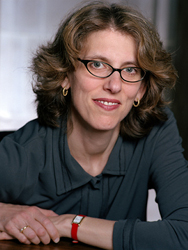
Juliet Schor, author, Plenitude
Instead she believes the proposed paradigm that focuses on innovation, macroeconomic balance and multiple sources of wealth will lead to greater well-being than the previous approach which, in her opinion, has led to the decline of economic and natural environments.
“My thinking has evolved in this way: The long term stagnation, high unemployment that I predicted is being borne out. What I didn’t expect was how difficult it is to get the mainstream conversation around to shorter working hours,” said Schor by email when asked about her reflections on the subject after the publication of the book. “I suppose I am also feeling more pessimistic about a government response to climate change.”
The author believes that there is growing interest among Hispanics and African-Americans to the ideas in the book. Some of the community innovations are happening in places like the inner-cities of Cleveland and Detroit, she pointed out via email. At the international level she is aware of interest among Indians in India in some of the lifestyle changes she favors such as organic food and low-impact lifestyles.
Schor is studying the concept of working environmental sustainability and its relation to Americans’ lifestyles and the economy as well as the rise of a conscious consumption movement. She has been a consultant to the United Nations, the World Institute for Development Economics Research, and the United Nations Development Program. She is a co-founder and co-chair of the Board of the Center for a New American Dream, a national sustainability organization.

Click to buy Plenitude
Comments:
Filed Under: Books
Posted by Elena del Valle on May 9, 2012

Young women drive a Ford Mustang convertible
Photos: Ford, General Motors
Sellers of products or services offline in old style brick and mortar offices and stores, especially those targeting a young demographic, may be interested to know that fewer young people have a driver’s license today than did their counterparts in the early 1980s, according to a University of Michigan study released December 2011. That means young customers without a driver’s license instead of self driving to visit an office or store have to rely on other means such as mass transportation, online shopping, and friends and family who have a car and drive.
The driver’s license study findings seem to match the declining sales of used cars, traditionally bought by young adults, young couples with children at home and married couples with adult children at home (they spend 72 percent more on average*). Average household spending on used cars dropped 30 percent between 2000 and 2007, according to *Best Customers Demographics of Consumer Demand.
While only 22 percent of drivers today are teenagers or in their twenties in 1983, one third of licensed drivers in the country were under 30 years old. That year, more than half of people with driver’s licenses were under 40 years of age and today less than 40 percent of drivers are under 40. The study authors did not analyze information by ethnicity or race.
Emerging market segments are well represented in young demographics. At the same time, Asian, Hispanic and black consumers spend more than the average household on mass transportation and spend less than the average household on transportation in general (Household Spending Who Spends How Much on What).
The researchers in Michigan believe there is a link between the decrease in driver’s license owners and the popularity of texting and electronic devices, activities and products that are popular among young Americans. Emerging market members tend to over index in their consumption of such products and electronic communication methods.

Sports cars like the GM Camaro 2012 may inspire people to get a driver’s license
“It is possible that the availability of virtual contact through electronic means reduces the need for actual contact among young people,” said Michael Sivak, research professor at the U-M Transportation Research Institute. “Furthermore, some young people feel that driving interferes with texting and other electronic communication.”
Sivak and Brandon Schoettle, a University of Michigan Transportation Research Institute colleague, examined the changes from 1983 to 2008 in the percentage of persons with permits to drive by age in a study in the journal Traffic Injury Prevention. They believe that there are fewer young people among all of today’s licensed drivers, and that young drivers are a smaller portion of their age group as a whole, compared to 1983.
That year, 87 percent of 19-year-olds had a permit to drive while in 2008 only 75 percent did. Likewise 80 percent of 18-year-olds had a license in 1983 and only 65 percent had one in 2008; 69 percent of 17-year-olds had a license in 1983 but only 50 percent did in 2008; and 46 percent of 16-year-olds had one in 1983 but only 31 percent did in 2008.
In 2008, people 70 and older were part of the largest group of drivers on the road, representing more than 10 percent of all drivers and a slightly higher percentage than those in their 40s or 50s. By that year licensed drivers as a percentage of their age group population had increased for all groups over 45 years of age since 1983. In 2008, 94 percent of those aged 65 to 69 and 78 percent of those 70 and older had drivers licenses, up from 79 percent and 55 percent, respectively, in 1983.
Some believe the recession, the cost of owning a car, migration trends toward large urban centers and the popularity of social media may account for some of the decline in driver’s permits among young Americans.
Looking internationally Sivak and Schoettle identified a similar pattern of a decrease in young drivers in seven countries and a contrary pattern in another seven countries in a subsequent study released this year, Recent Changes in the Age Composition of Drivers in 15 Countries. They concluded in their analysis that “higher societal wealth, older population in general, and higher proportion of population living in megacities were each associated with higher licensure rates among young persons.” In that study, they found that the more internet users present the lower licensure rates among youth.




























